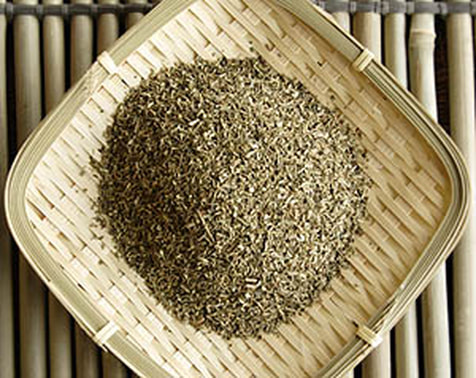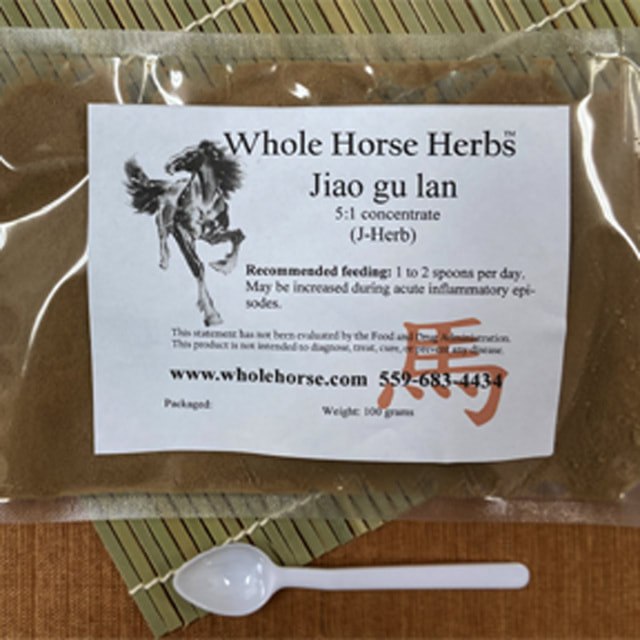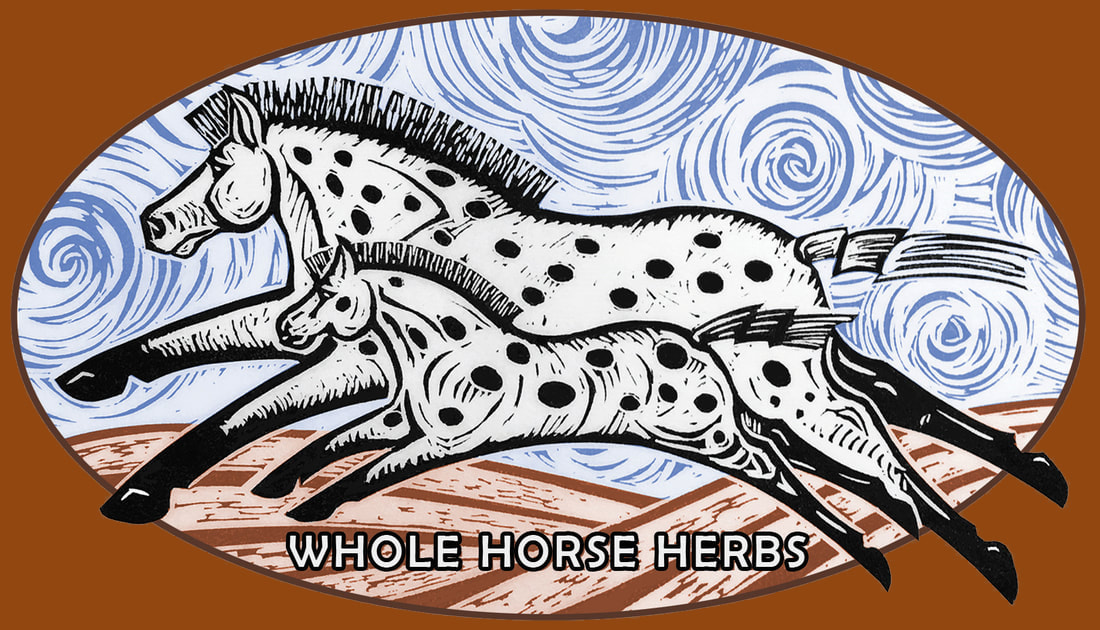Equine Laminitis
Jiao Gu Lan & Laminitis
 Jiao gu Ian used for Founder treatment
Jiao gu Ian used for Founder treatment
By Gloria Garland L.Ac, Dipl. Ac. & CH.
Jiao gu lan (Gynostemma), also known as “the poor man’s ginseng,” has been used in Asia for hundreds of years but only in the last twenty years has it come to our attention here in the west through Japanese research as a treatment for cardiovascular disease. (1)
Recent research into Jiao gu lan and its ability to reduce vascular inflammation may offer therapeutic options for horses recovering from laminitis.
The traditional Chinese medicine (TCM) view is that Jiao gu lan’s therapeutic actions are heat (inflammation) clearing and toxin (bacterial or systemic infections) eliminating. From the western perspective, it has anti-inflammatory properties, whichcounteract the release of endothelin, a hormone that causes vessel constriction and shut down. Additionally, it stimulates the production of nitric oxide.
Nitric oxide, a small reactive molecule, is critical to a wide range of biological activities from digestion to regulating blood pressure. Nitric oxide enables adequate circulation through tissues and blood vessels. Simply stated, it relaxes the blood vessels to facilitate blood flow. This is where Jiao gu lan may help the horse suffering from laminitis.
A recent field trail investigating the effectiveness of Jiao gu lan concluded that of the 118 horses and ponies treated with Jiao gu lan, fifteen (12.7%) failed to respond, fifty seven horses (48.3%) showed complete return to soundness at a walk within 2 days to 2 weeks of starting Jiao gu lan. The remaining forty-six horses (39%) showed obvious improvement of 1 to 2 lameness grades and were stable or continuing to improve at the end of the follow up. (2)
Laminitis is a complicated problem that requires immediate veterinary attention and should not be treated with herbs alone. It can be triggered by a variety of conditions including colic, bacterial infections, endotoxins, insulin resistance (IR), stress, trauma, pregnancy or Cushing’s disease.
A successful plan for dealing with laminitis includes identifying the cause and removing it or treating it, scrupulous hoof care with frequent trimmings and strict diet management.
While there is no magic cure for laminitis, Jiao gu lan is one of many promising treatment tools available to help horses regain hoof health.
Chinese herbal supplements should be used properly and thoughtfully under the guidance of a licensed Chinese herbalist. Traditional Chinese Medicine (TCM), used properly, is an adjunctive therapy and, therefore, complementary to veterinary treatment. Information presented here is not intended to replace proper veterinary diagnosis or treatment and should not be used for that purpose.
References:
1. Chen, John K., PhD, PharmD, OMD, Lac., Gynostemma: An Undiscovered Treasure.Acupuncture Today September, 2002, Volume 03, Issue 09
2. Kellon, Eleanor, DVM, “Jiaogulan and Laminitis”, 30 May 2005
Herbs for Laminitis - education series #1
Jiao gu lan (Gynostemma), also known as “the poor man’s ginseng,” has been used in Asia for hundreds of years but only in the last twenty years has it come to our attention here in the west through Japanese research as a treatment for cardiovascular disease. (1)
Recent research into Jiao gu lan and its ability to reduce vascular inflammation may offer therapeutic options for horses recovering from laminitis.
The traditional Chinese medicine (TCM) view is that Jiao gu lan’s therapeutic actions are heat (inflammation) clearing and toxin (bacterial or systemic infections) eliminating. From the western perspective, it has anti-inflammatory properties, whichcounteract the release of endothelin, a hormone that causes vessel constriction and shut down. Additionally, it stimulates the production of nitric oxide.
Nitric oxide, a small reactive molecule, is critical to a wide range of biological activities from digestion to regulating blood pressure. Nitric oxide enables adequate circulation through tissues and blood vessels. Simply stated, it relaxes the blood vessels to facilitate blood flow. This is where Jiao gu lan may help the horse suffering from laminitis.
A recent field trail investigating the effectiveness of Jiao gu lan concluded that of the 118 horses and ponies treated with Jiao gu lan, fifteen (12.7%) failed to respond, fifty seven horses (48.3%) showed complete return to soundness at a walk within 2 days to 2 weeks of starting Jiao gu lan. The remaining forty-six horses (39%) showed obvious improvement of 1 to 2 lameness grades and were stable or continuing to improve at the end of the follow up. (2)
Laminitis is a complicated problem that requires immediate veterinary attention and should not be treated with herbs alone. It can be triggered by a variety of conditions including colic, bacterial infections, endotoxins, insulin resistance (IR), stress, trauma, pregnancy or Cushing’s disease.
A successful plan for dealing with laminitis includes identifying the cause and removing it or treating it, scrupulous hoof care with frequent trimmings and strict diet management.
While there is no magic cure for laminitis, Jiao gu lan is one of many promising treatment tools available to help horses regain hoof health.
Chinese herbal supplements should be used properly and thoughtfully under the guidance of a licensed Chinese herbalist. Traditional Chinese Medicine (TCM), used properly, is an adjunctive therapy and, therefore, complementary to veterinary treatment. Information presented here is not intended to replace proper veterinary diagnosis or treatment and should not be used for that purpose.
References:
1. Chen, John K., PhD, PharmD, OMD, Lac., Gynostemma: An Undiscovered Treasure.Acupuncture Today September, 2002, Volume 03, Issue 09
2. Kellon, Eleanor, DVM, “Jiaogulan and Laminitis”, 30 May 2005
Herbs for Laminitis - education series #1



